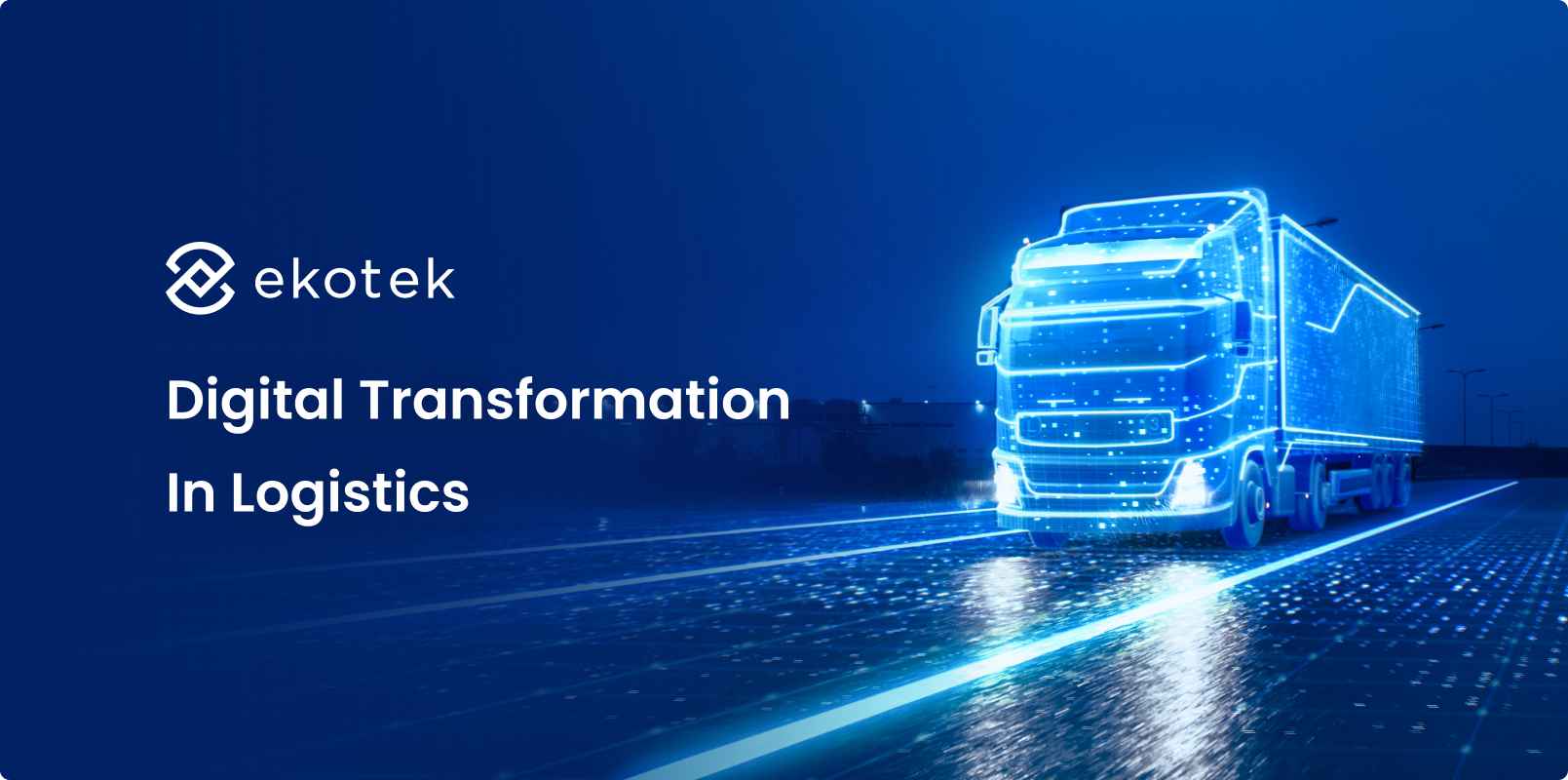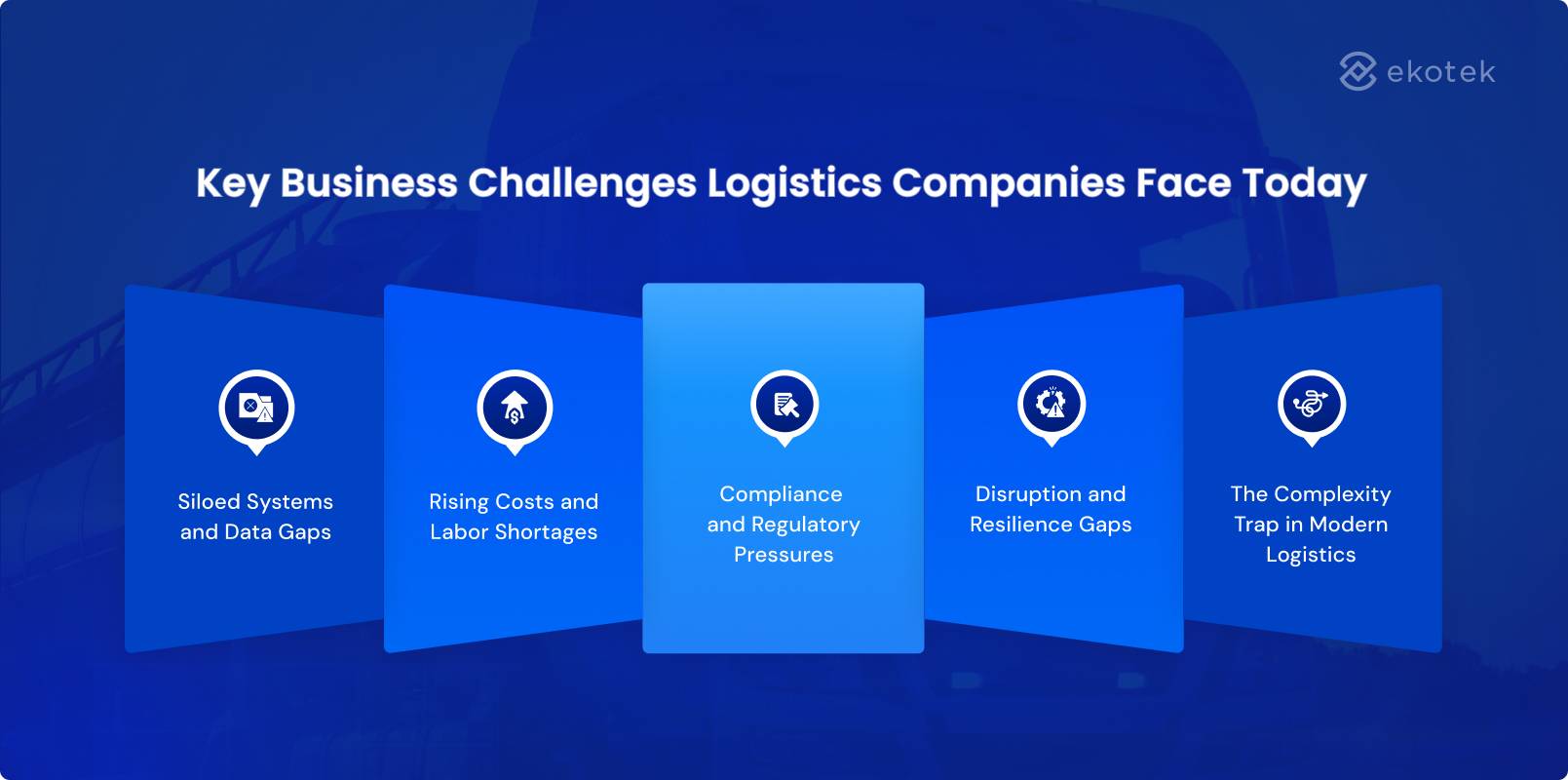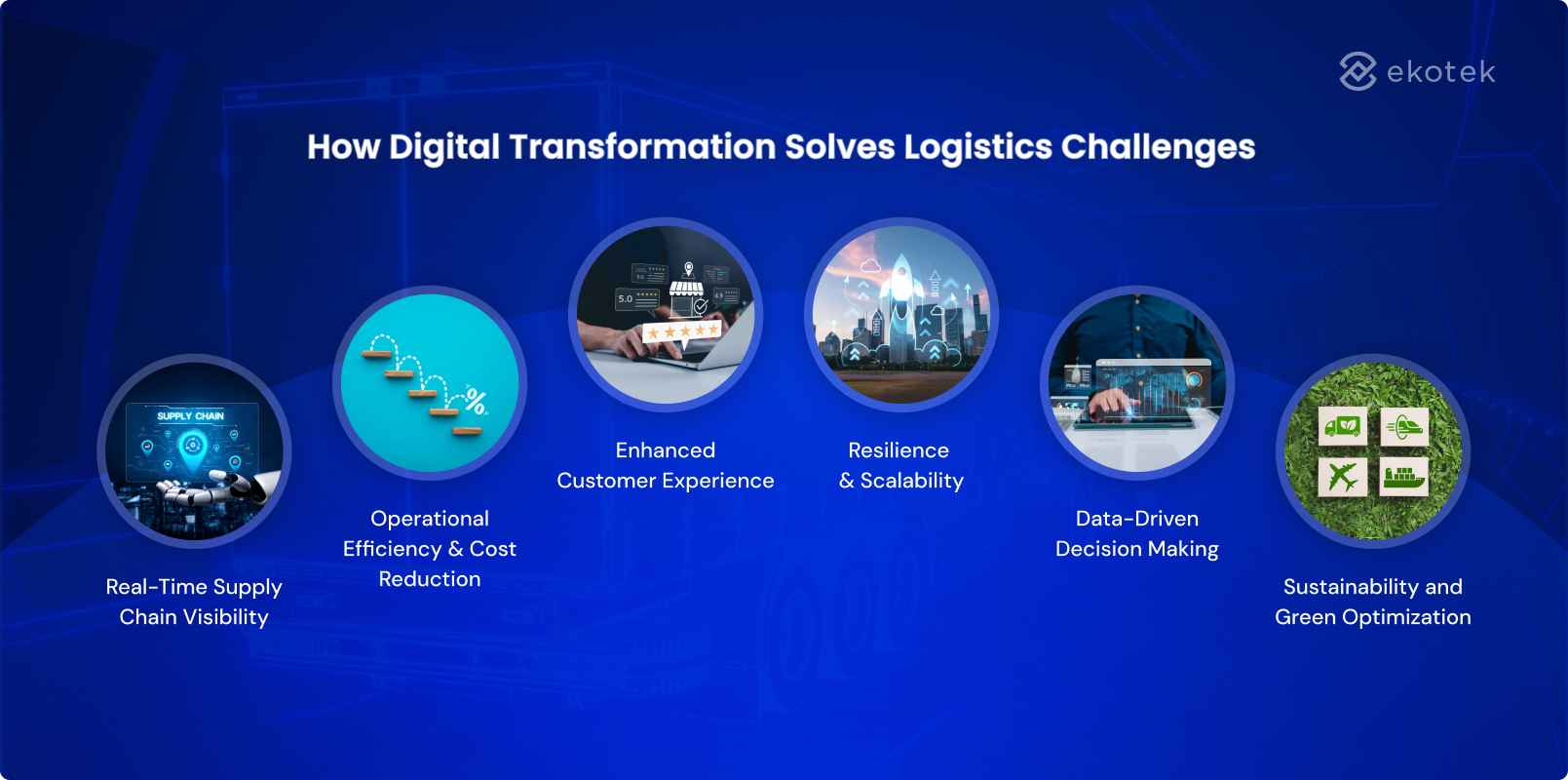
- 1
- 2
- 3
- 4
- 5
- 6
- 7
- 8
Introduction: Why Digital Transformation Matters in Logistics
In the world of logistics, the only constant is change, and in 2025, the pace has never been faster. Picture a leading supply chain executive at a global logistics firm staring at a real-time dashboard: every delivery traceable, exceptions flagged instantly, and problems proactively resolved. Now, contrast this with a company struggling with manual paperwork, late shipments, and costly disruptions. The gap between these two realities has widened dramatically, thanks to the accelerating impact of digital transformation in logistics.
But what’s truly at stake goes beyond technology. Logistics leaders today face a perfect storm: fragile supply chains, relentless cost pressures, and an unforgiving customer base conditioned by the “Amazon effect.” In this environment, digital transformation isn’t just a buzzword; it’s a competitive requirement. This guide offers logistics providers and supply chain executives actionable frameworks, success benchmarks, and the latest trends to drive strategic results from digitization.
What Is Digital Transformation in Logistics?
Digital transformation in logistics refers to the strategic adoption of digital technologies to improve how goods, information, and processes move across the supply chain. It’s about reimagining logistics operations through data, connectivity, and intelligence.
At its core, digital transformation integrates advanced tools such as artificial intelligence (AI), the Internet of Things (IoT), cloud computing, and blockchain to enhance visibility, efficiency, and collaboration. These technologies enable logistics providers to track shipments in real time, predict disruptions before they occur, and optimize routes, inventory, and customer interactions dynamically.
The goal is simple but transformative: to create a connected, agile, and data-driven logistics network capable of responding instantly to market shifts, customer demands, and global disruptions. In an industry where timing and transparency define success, digital transformation turns traditional supply chains into intelligent ecosystems that learn, adapt, and deliver value continuously.
Key Business Challenges Logistics Companies Face Today
 Logistics firms are navigating a landscape more volatile and demanding than ever. For B2B leaders and operations executives, each day presents fresh hurdles: shipping delays cost valuable accounts, fragmented IT systems hinder end-to-end visibility, and forecasts shift rapidly with every global disruption.
Logistics firms are navigating a landscape more volatile and demanding than ever. For B2B leaders and operations executives, each day presents fresh hurdles: shipping delays cost valuable accounts, fragmented IT systems hinder end-to-end visibility, and forecasts shift rapidly with every global disruption.
Imagine a typical morning for a logistics team leader: a customer rings about a delayed shipment. The team scrambles, toggling between spreadsheets and legacy software, unable to pinpoint the truck’s location or the cause of the holdup. By the time the package arrives, trust has been eroded, both in the relationship and in the process.
This scenario is common, and so are the central pain points:
- Siloed Systems and Data Gaps: Most logistics companies still struggle with disjointed IT architectures. Critical information, from inventory levels to route status, lives in separate silos, requiring manual intervention to collate and interpret. According to a 2025 PwC report, an astonishing 70% of logistics firms identify end-to-end supply chain visibility as their number one pain point.
- Rising Costs and Labor Shortages: As demand for next-day and omnichannel delivery surges, companies face higher transportation costs, fluctuating fuel expenses, and severe labor shortages. Manual processes compound these challenges, leading to cost overruns and missed deadlines.
- Compliance and Regulatory Pressures: Whether it’s tightening emissions standards or cross-border trade compliance, logistics teams find themselves investing more time and resources in staying up to date. These pressures are amplified by the growing emphasis on green digital supply chain and ESG objectives.
- Disruption and Resilience Gaps: The pandemic laid bare how vulnerable even the largest logistics networks can be to sudden shocks. Supply chain managers must now grapple with more frequent disruptions, ranging from natural disasters to cyber-attacks, often without the tools for real-time risk assessment.
- The Complexity Trap in Modern Logistics: Compounded by globalization and the relentless move to omnichannel models, today’s logistics networks are forced to deliver more, faster, and at a lower cost. Customer expectations for tracking and transparency have become table stakes, yet most companies lack the real-time insight to fulfill them reliably.
How Digital Transformation Solves Logistics Challenges
 Real-Time Supply Chain Visibility
Real-Time Supply Chain Visibility
Imagine a logistics operation where every shipment, from origin to destination, is tracked in real-time. Leading companies like DHL have achieved this by integrating AI, IoT devices, and robust supply chain digitalization platforms. Real-time dashboards flag delays as they happen, rather than after the fact. At DHL, predictive tracking has reduced late deliveries by up to 40%, freeing teams to focus on proactive problem-solving rather than constant firefighting.
FedEx, meanwhile, leveraged IoT sensors and analytics to monitor cargo integrity, achieving lower loss rates and faster incident responses. These advances enable not only operational transparency but also build customer trust, a crucial differentiator.
📌 Discover how Ekotek’s AI Development Services can transform your business
Operational Efficiency & Cost Reduction
Automation, robotics, and AI not only improve accuracy but also drive radical cost savings. DHL’s adoption of warehouse robotics and AI-driven sorting achieved a 25% reduction in labor costs and improved throughput by 30%. McKinsey finds that logistics companies who undergo digital transformation see a 10-40% boost in operational performance and 60% stronger EBITDA protection.
Ekotek takes digital transformation further by developing AI-powered agents that automate complex manufacturing processes. Our intelligent solutions can automatically generate Bills of Materials (BOM), helping production companies save significant time, reduce human error, and cut operational costs. By integrating AI-driven decision-making into logistics and production workflows, we enable businesses to achieve new levels of efficiency and scalability
📌 Read more about our AI-powered automation success story here
Enhanced Customer Experience
Digital transformation flips the script on customer relationships. Real-time notifications, live tracking, and transparent exception handling mean fewer customer complaints and faster resolution when issues arise.
DHL’s customer portals provide instant access to status, documents, and proactive alerts, slashing wait times and support inquiries. The result is clear: higher NPS scores and longer-term contracts.
Resilience & Scalability
Perhaps the most overlooked benefit, digitization arms logistics providers with the agility to respond to shocks, be it a supply chain disruption or a sudden spike in demand. With cloud-based platforms and AI-driven forecasting, logistics leaders can reallocate assets, reroute freight, and communicate changes instantly.
In 2020, FedEx’s digitized systems enabled agile re-routing during unprecedented border closures, avoiding millions in lost shipments. McKinsey notes that digitally mature firms outperformed their peers by 60% in EBITDA resilience during crises.
Data-Driven Decision Making
Digital transformation enables logistics leaders to make faster, smarter, and more accurate decisions. By connecting data across transportation, warehousing, and customer systems, organizations gain a unified, real-time view of their operations.
Predictive analytics and machine learning models can forecast demand surges, optimize fleet utilization, and detect potential disruptions before they occur. According to Gartner, logistics companies that leverage advanced analytics achieve up to 35% faster decision-making cycles and significantly higher planning accuracy.
With centralized dashboards and automated insights, teams can move from reactive problem-solving to proactive strategy, turning data into a competitive advantage.
Ekotek deliver tailored digital transformation from the ground up. For a global medical-equipment manufacturer, we replaced cumbersome Excel-based workflows with custom production software and Power BI–integrated dashboards, working via a dedicated development team. Thanks to our solution, the client now enjoys fewer manual errors, faster cross-department coordination, and real-time visibility across production units. That’s how we help manufacturers transform data into actionable insights, drive productivity, and reduce costs, all in one unified system.
Sustainability and Green Optimization
Sustainability has become a core driver of transformation across the logistics industry. Through digital tools and IoT-enabled visibility, companies can monitor emissions, optimize routes, and minimize waste with greater precision.
AI-powered analytics suggest more fuel-efficient transportation paths, while warehouse management systems track energy usage and identify opportunities for reduction. DHL’s GoGreen initiative, for instance, demonstrates how digitalization can support carbon-neutral logistics through data transparency and continuous optimization.
📌 Learn more about Generative AI in digital transformation
By aligning environmental goals with operational performance, logistics providers not only meet tightening regulations but also strengthen brand reputation and long-term resilience.
Future Trends in Logistics Digitalization
The horizon for logistics is ablaze with innovation. For executives mapping investments through 2025 and beyond, several transformative trends stand out, offering both new promise and new pressure to keep pace.
Consider this future-focused scenario: An order is received in Tokyo. Moments later, an AI-powered platform selects the ideal warehouse, dispatches a self-driving truck, and orchestrates a zero-emissions delivery, dynamically adjusting for weather, fuel costs, and customs clearance.
Let’s break down the trends shaping the digital supply chain era ahead.
Autonomous Logistics: Drones, Robotics, and Self-Driving
Autonomous vehicles and robotics are rewriting the last-mile delivery rulebook. DHL and JD.com now deploy drones for remote deliveries, reducing costs and slashing lead times by 50% for specific routes. By 2027, Gartner predicts that over 35% of cross-border shipping lanes will be managed by AI/ML platforms, many leveraging autonomous logistics technologies.
Self-driving trucks are in advanced pilot phases in the US and China, while automated guided vehicles (AGVs) are becoming standard in major warehouses. These advances promise not only speed, but also improved safety and lower labor costs.
📌 Save time, cut costs, and scale faster with Manufacturing Process Automation
AI-Powered Predictive Logistics
The heart of next-gen logistics is data. AI and machine learning now power route optimization, inventory forecasting, and real-time decision-making. Amazon leverages machine learning to optimize shipment routes and warehouse layouts, lowering operational costs and raising fulfillment accuracy.
📌 See what’s possible with AI – check out the Top 20 AI Agent Use Cases
Green Logistics and Emissions Tracking
Sustainability is moving from aspiration to obligation. Digital tools empower companies to quantify, track, and optimize carbon emissions across every shipment. Amazon’s green warehouse analytics platform has set industry benchmarks for transparency and performance, while DHL’s digital twin technology simulates end-to-end carbon outcomes.
New regulatory standards will increasingly require emissions reporting down to the shipment level, making robust green digital supply chain tools a strategic necessity.
Connected Digital Ecosystems
The future of logistics is connected. Supplier networks, 3PLs, carriers, and customers are plugging into shared digital platforms, enabling seamless data flow and collaboration. MIT’s forecast suggests that, by 2026, ecosystems will be the norm, radically improving transparency, trust, and speed.
Integration is key: API-driven architectures, blockchain-secured transactions, and universal standards are powering a new era of open, dynamic supply chains.
Security, Compliance, and RegTech
With digitization comes new risk: data breaches, cyber-threats, and complex compliance requirements. Investment in cybersecurity, privacy, and advanced regulatory technologies (RegTech) is growing. Leading providers are already embedding multi-layered security and real-time monitoring into their digital logistics platforms to stay ahead of regulations and customer demands.
📌 Explore the Top Digital Transformation Trends shaping the future of business
Measuring the Impact of Digital Transformation in Logistics
To turn digital transformation from a vision into measurable business value, logistics leaders must track clear, data-driven performance indicators. The following key metrics help quantify how digitization accelerates growth, efficiency, and resilience across modern logistics operations:
Process Efficiency
Evaluate how digital tools improve shipment turnaround, warehouse throughput, and delivery accuracy. Automation, IoT tracking, and advanced analytics can significantly shorten lead times and reduce human error.
Customer Experience Metrics
Monitor Net Promoter Scores (NPS), complaint resolution time, and delivery satisfaction levels to gauge how digital visibility and proactive communication enhance customer loyalty.
Financial Performance
Track revenue uplift from new digital services, optimized pricing, and cross-platform integration. Analyze profit margins to see how automation and predictive maintenance lower operating costs.
Cost Optimization
Quantify reductions in logistics expenses through automated invoicing, smart routing, and asset utilization. Compare pre- and post-transformation cost baselines to calculate tangible savings.
Supply Chain Transparency
Measure real-time visibility across suppliers, transport routes, and inventory networks. Higher visibility directly correlates with faster exception handling and improved stakeholder trust.
Workforce Productivity
Assess time saved per task, workload reduction, and employee satisfaction as automation removes repetitive manual work—allowing teams to focus on higher-value activities.
📌 Unlock productivity and collaboration through Digital Workplace Transformation
Innovation Velocity
Track the pace of digital innovation: new platforms launched, data integrations completed, or AI pilots scaled. A higher rate of experimentation often signals stronger digital maturity.
Sustainability and ESG Impact
Analyze how digital solutions support carbon reduction, route optimization, and eco-friendly logistics models. Use emissions-tracking dashboards to align sustainability targets with business performance.
Return on Digital Investment (RODI)
Evaluate the financial return from transformation initiatives by comparing implementation costs with the gains in efficiency, customer retention, and revenue.
By consistently measuring these metrics, logistics companies can demonstrate the tangible business value of digital transformation—and continuously refine their strategy to stay ahead in an increasingly data-driven industry.
📌 Accelerate innovation and efficiency with Ekotek’s Digital Transformation Services
Final remarks
Digital transformation is redefining logistics, turning fragmented, reactive operations into intelligent, data-driven ecosystems. From AI and automation to predictive analytics and connected digital platforms, technology is now the cornerstone of agility, efficiency, and customer trust. For logistics and manufacturing leaders, success in 2025 and beyond will hinge on how effectively they harness these innovations to cut costs, boost resilience, and unlock new growth
Ekotek is a trusted partner for this journey, bringing together domain understanding and disciplined engineering to deliver digital transformation that lasts. We provide tailored consulting, solution design, and full-cycle product development to modernize legacy workflows and build cloud-ready, API-first systems, complete with actionable dashboards, secure data pipelines, and automation at scale. Our teams work side-by-side from discovery to rollout and post-launch optimization, integrating AI/ML, blockchain, and analytics where they create real value. Whether you aim to streamline operations, reduce time-to-decision, or scale new digital services, Ekotek helps turn strategy into measurable outcomes.
FAQ on Digital transformation in logistics
1. What does digital transformation in logistics actually mean for my business?
Digital transformation in logistics is more than just adopting new software, it’s about rethinking your entire supply chain to become data-driven, connected, and intelligent. It enables real-time visibility, predictive decision-making, and automation that improve delivery accuracy, reduce operational costs, and strengthen customer trust.
2. How can digital transformation help us reduce costs and increase efficiency?
By integrating technologies like AI, IoT, and automation, logistics operations can eliminate manual tasks, optimize routes, and minimize downtime. This leads to measurable gains in productivity, resource utilization, and profitability, often achieving 20–40% efficiency improvement across key workflows.
3. What are the biggest challenges companies face during digital transformation?
Common challenges include fragmented legacy systems, lack of data integration, and cultural resistance to change. Successful transformation requires a clear roadmap, leadership commitment, and the right technology partner to ensure systems and teams evolve together toward a unified digital strategy.
4. Where should business leaders start when planning a logistics digital transformation?
Begin with a clear understanding of your operational pain points and define measurable outcomes, such as improving delivery speed, visibility, or cost efficiency. From there, prioritize quick-win projects that demonstrate value early, like data dashboards or automation pilots, and scale gradually with a long-term roadmap that aligns technology investment with business goals.
- 1
- 2
- 3
- 4
- 5
- 6
- 7
- 8